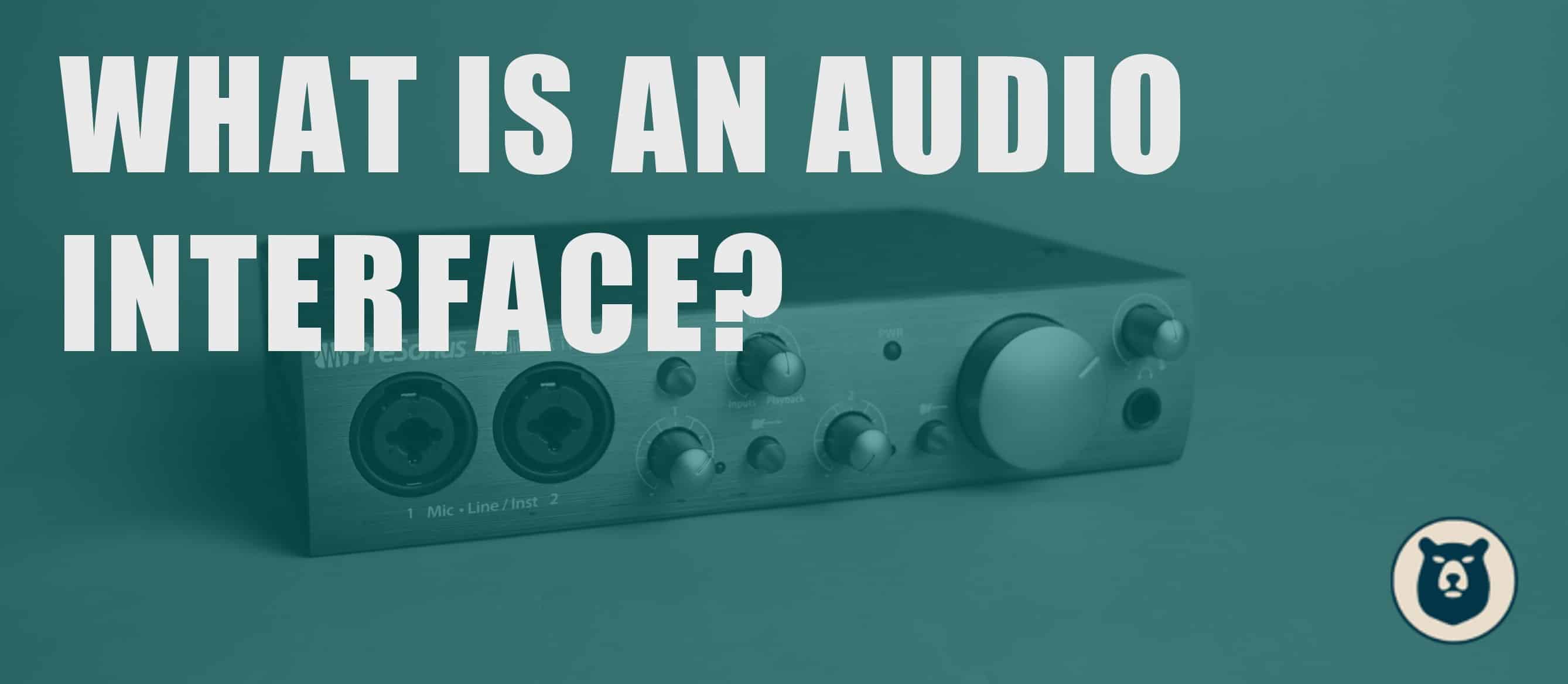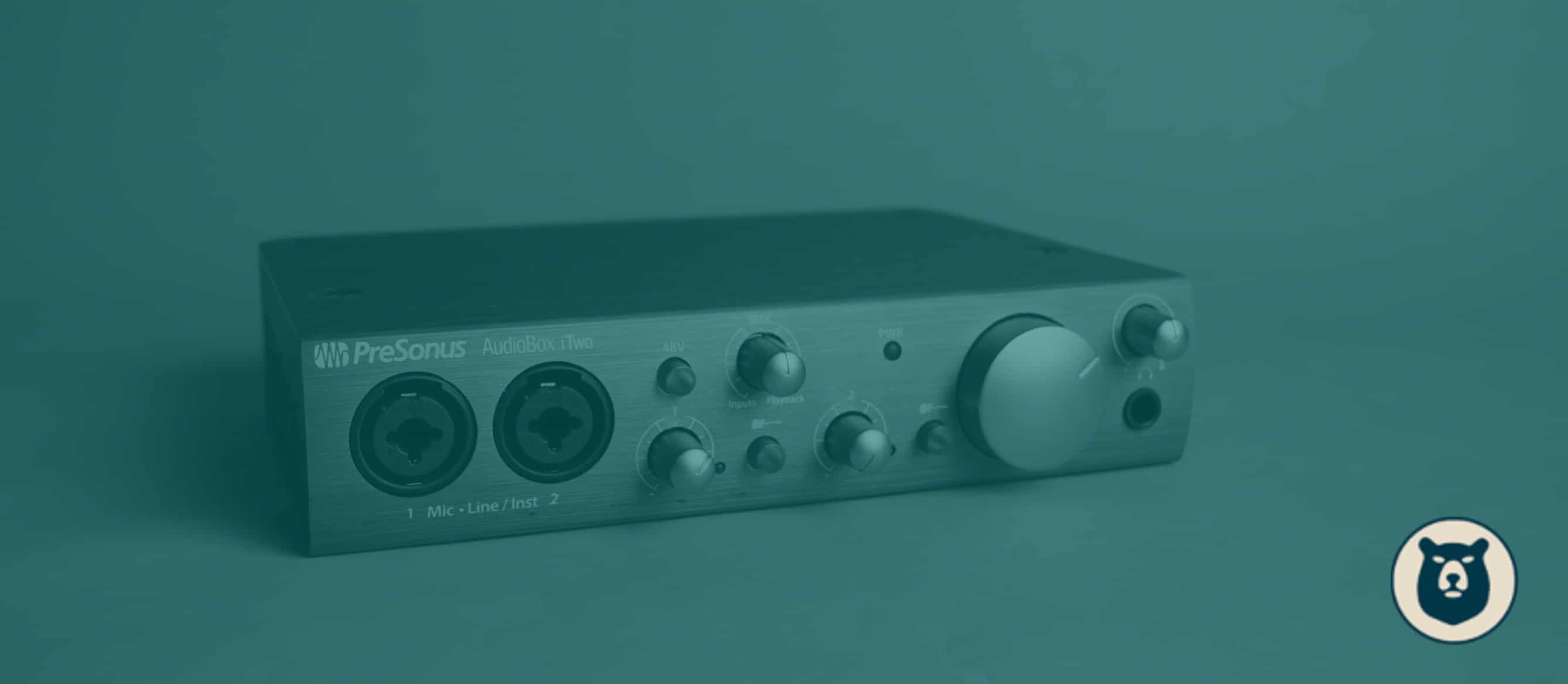
If you are just getting into music production you might be thinking yourself:
What is an audio interface?
I have a sound card on my computer so why would I need an audio interface?
And those are great questions. So let’s start with the first.
What is an audio interface?
An audio interface is a device that allows you to bring in a whole host of different sounds from microphones, instruments, keyboards, synths and other sound sources into your computer. It becomes a central hub that passes all the audio signals into and out from your computer to different parts of your studio.
Basically it is the brain of your music production operation.
Most of the time you’re more concerned about sounds coming into your computer. But there’s also this whole other world of the sounds leaving your computer. You can actually make the sound leave your computer and go out to a whole bunch of external gear as well.
And that’s a crazy and exciting world.
I have a whole article that talks about just audio interface outputs if you are curious to see some of the different options you have with outputs from an audio interface.
Is an audio interfaces the same as a sound card?
Yes and no.
Now let’s back up to that second question you had:
If I have a sound card why do you need an audio interface?
The reality is you can use your sound card to get sounds into your computer.
But it’s not as effective and it doesn’t have as many options as an audio interface.
Most of the time your computer’s sound card has a limited number of inputs.
And limited number of ways that things can be brought into your computer.

Can’t I just use the input on my soundcard?
Most of the time on a sound card there is only one ⅛” jack to bring sound into your computer. On laptops, there is usually only one jack for headphones, and then built in mics in the laptop itself.
Professional microphones work off of XLR inputs. And most condenser microphones need phantom power, which is not available through the computer’s sound card.
If you look at most professional gear that’s out there today, you won’t find very many microphones or instruments that operate off of an ⅛” jack.
Most professional microphones, instruments, synths, keyboards and other sound modules use inputs like XLR or ¼” cables to output their sound.
And we’re trying to set ourselves up to be able to record any kind of mic and instrument. That gives you the most flexibility in your music production.
Another consideration is that the sound card quality is usually lower than what you can get from an audio interface.
The drivers that are part of a built in sound card can end up causing a lot of lag when you are trying to record something. This results in latency issues. That’s a problem when you are recording. And if you do try to record with those ⅛” inputs, you’ll likely find that there is a lot of noise on the recording.
Which means that whatever you might be able to record with your sound card probably won’t sound as good as what you can get from an audio interface.
And that’s the whole point. We’re trying to get good recordings so that we can use those for our songs or for our music production.
So what is the purpose of an audio interface?
Like I said earlier, the audio interface is used as the brain of your music production.
It’s the device that routes everything in and out of the computer. And it allows you a lot of flexibility on what you can record and how you can record it.
It is designed in a way that you get high quality audio coming in and going out.
And the drivers are designed in such a way that you have low latency when you are recording.
And when you are doing music production, you want to have as many options as possible.
Do I need an audio interface if I have a USB microphone?
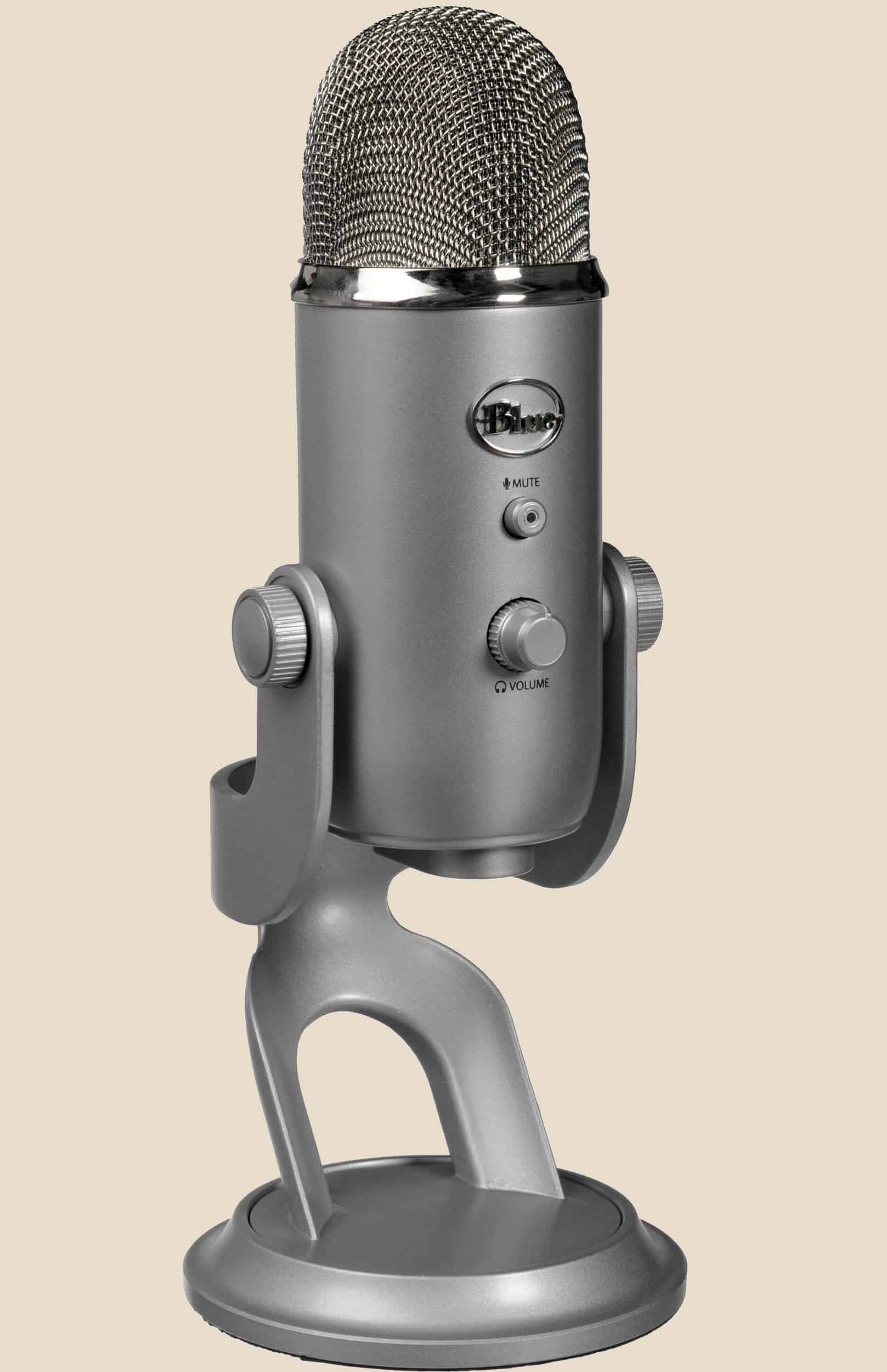
So maybe you have a USB microphone already.
Most of those USB microphones have a built-in audio interface. And sometimes they even have a headphone output so you can listen to what you’re recording.
But there’s a limitation with that.
You might able to record your voice, or an acoustic guitar.
But what about instruments like your keyboard? How are you going to get it into your computer?
Or maybe you have an electric guitar, or bass, but you don’t have an amp. How are you going to record that sound into the computer.?
Some people might be able to get by with just a USB microphone, but I think if you play multiple instruments you can see that it might be beneficial to have an audio interface instead of just a USB microphone.
Again, we are all about flexibility and room to grow as we develop as music producers.
How do I connect my audio interface to my computer?
Let’s say you’re sold on the idea getting an audio interface.
And you’re wondering how do I actually hook up that audio interface to my computer?
This is where you’ll start seeing some terms that you may or may not be familiar with.
The terms are firewire, Thunderbolt, USB, and PCIE. These are all different connections that can help you connect your audio interface to your computer. But before you purchase one, you need to figure out what kind of connections you have on your computer.
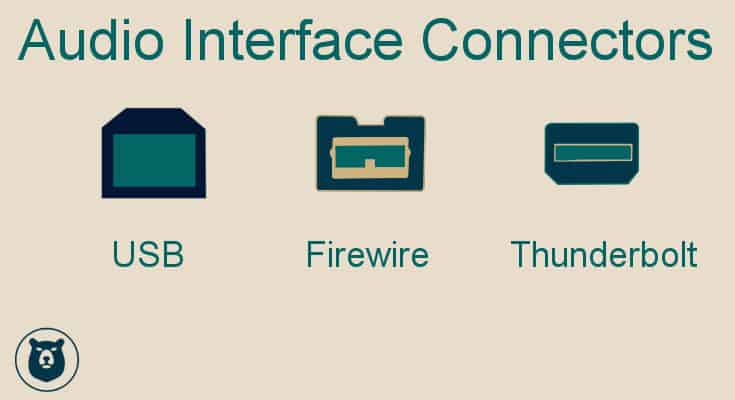
The most common these days are USB and Thunderbolt.
Firewire is starting to get phased out.
So figure out what connections you have on your laptop or computer before you purchase an interface.
Let’s move on to some more technical terms that you might see when you start shopping for audio interfaces.
Nerdy Terms about audio interfaces
You may also see some other kind of terms when you look at audio interfaces on a website like Sweetwater, Amazon, Musician’s Friend or one of those other big retailers that sell audio interfaces.
You’ll see terms 18/28 i/o, sample rate, bit depth, A/D, D/A preamps, etc.
It can seem a little bit intimidating at first, but I’ll break it down pretty simply for you so that it doesn’t feel like you have to bust out the horn rim glasses and calculators to understand.

So here we go.
I/O
I/O is just a shortened term for inputs and outputs. This just means the way that you get the audio in and out of the audio interface and this can be done through a variety of connections like XLR, ¼”, SPDIF, ADAT, etc.
For example you may see an audio interface that talks about 18 input and 20 outputs.
If you look at the front and the back of the interface it may have 8 line/mic inputs, an ADAT in (which gives you up to 8 inputs), a SPDIF input, and a midi input.
That’s your 18 inputs.
Then it has 8 line outputs, ADAT output (up to 8 outputs), Midi output, SPDIF output and 2 monitor outputs.
That gives you 20 outputs.
So it’s good to be aware of what kinds of inputs and outputs are available on the audio interface.
This gives you a good idea for how you can expand your setup in the future.
Sample rate
This is just the number of times that a sound is sampled on its way into the computer. So a sample rate of 48 kHz means that the sound is sample 48,000 times per second on it’s way in.
Basically the more times the sound is sampled per second on the way in, the higher the quality of the sound, and the more information you have to work with and manipulate in your recording software.
The drawback is that the larger the sample rate, the more data (i.e. the more hard drive space) it takes up on your computer.
Most modern interfaces that are good will give you up to 192 kHz sampling rate.
Bit depth
Bit depth is just another fine measurement of the quality of the audio you are recording. So a sample rate of 48 kHz with 16 bit depth means that you have 16 bits that are describing each of the 48,000 samples you’ve taken.
So if you have a sample rate of 48 kHz with 24 bit depth, it means you have 24 bits that describe each of those 48,000 samples. Again, the larger the bit depth means more data, which means it takes up more hard drive space.
A/D
A/D is analog to digital conversion. This is the process that happens when you take what you sang to into the microphone and it gets turned into an audio file on the computer. It starts analog, and is then converted into digital by your interface.
The interface has built in converters that handle all that technical stuff for you. The higher quality the converters, the more expensive the audio interface will be.
D/A
D/A is the opposite process as A/D. When the audio files on your computer are translated out to something analog, like your speakers, this is D/A. This conversion from digital to analog also happens in the audio interface.
That’s why you can think of your audio interface as a higher quality sound cards for your computer. But it’s external, which means that it’s not as susceptible to the noise in your computer. And it has higher quality sampling and conversion.
Preamps
Preamps are devices that help you amplify sound to a level that is usable. Most audio interfaces have at least one preamp, but the more preamps the interface has, the more expensive it is going to get.
Basically a microphone on its own doesn’t produce a usable signal. You have to have a preamp in order to amplify whatever you are capturing with your microphone or line input.
When you are starting out and recording on your own, chances are you can get away with one or two inputs. But as you grow in music production, you may want to have more options.
Most interfaces will come with at least one or two preamps built into them.
But the cheaper the interface, the lower quality those preamps will be.
This means that you will have more noise on those preamps.
What are the most popular audio interfaces?
So if you do a search through Amazon, you can figure out what some of the best selling audio interfaces are. Right now the top five audio interfaces on Amazon are the ones that follow:
Focusrite Scarlett Solo
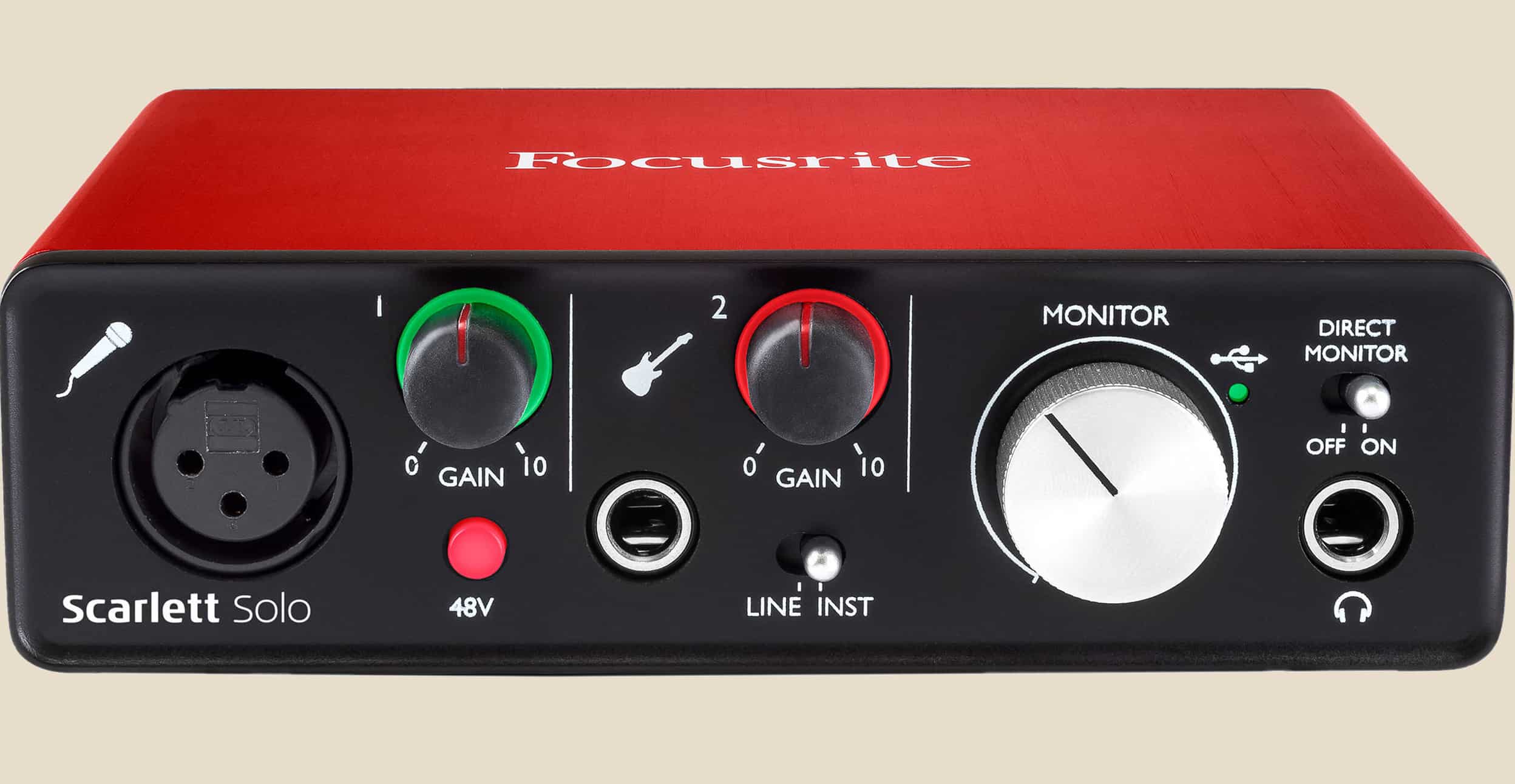
This interface comes in around $100.
But there are some serious limitations with this interface.
You can only record one microphone and one instrument.
And the only outputs on the back are RCA outputs, which means that you can’t connect out to studio monitors later on down the road.
Which is something that you will probably want to invest into as you grow in your music production career. But if you simply just want to dabble in audio recording then this might be a decent option for you.
BEHRINGER U-PHORIA UM2
This one is like the focusrite Scarlett solo except it looks a lot lower quality.
It only has one microphone input and only one instrument input.
Another limitation on this device is that you can only record up to a sample rate of 48 kilohertz.
While that’s not a bad thing just for when you’re starting out it’s a limiting if you want to work on projects and higher quality audio.
In my opinion the interface just looks cheap. I would avoid it.
BEHRINGER U-PHORIA UMC22
This one is pretty much identical to the interface listed above except that it has studio monitor line outputs on the back of the interface.
That’s really the only difference between this interface in the one above.
The price point is just a little bit more but again it just doesn’t look very high quality.
IK Multimedia iRig 2 guitar interface adaptor for iPhone, iPod touch, iPad, Mac and Android
This one is more an interface that set up to work with iphones.
And it’s set up with an ⅛” Jack.
Most of the newer phones are operating off of USB C or a lightning adapter which means that you’d have to have an extra dongle in order to be able to use this interface.
And it’s pretty specifically setup for guitar.
So this one really can’t record microphones.
You can only plug an instrument cable into the interface.
This is not a really great option if you’re looking to do any sort of audio recording that requires a microphone.
These are just my opinions
These are just my opinions on the audio interfaces that are listed as the top sellers on Amazon.
If you see something on that list that you really like, by no means let me discourage you from getting that. That’s totally your call.
You have to think about what’s best for you in terms of budget and quality and what you’re aiming for.
But when I look at this list, I don’t think these are the best options for audio interfaces.
They might be the most affordable, but they’re probably not the best quality.
What I Recommend for an Audio Interface
So instead of recommending that you buy one of those interfaces, I would recommend that you look at some of the ones listed below. These are recommendations if you’re just starting out.
Maybe this is just a hobby right now, but you’re not pursuing music production full-time yet. You want to dip your toes in the water, but don’t want to drop a ton of money on gear.
All of the interfaces I recommend below offer the same basic functionality: two inputs, two outputs. These are starter interfaces that will come in under $200.
I also only put USB interfaces in this list. The reason I did that is because Firewire is getting phased out of mainstream use. And Thunderbolt and USB-C is not on everything yet.
USB is the one common factor across most computers at this point.
PreSonus AudioBox iTwo
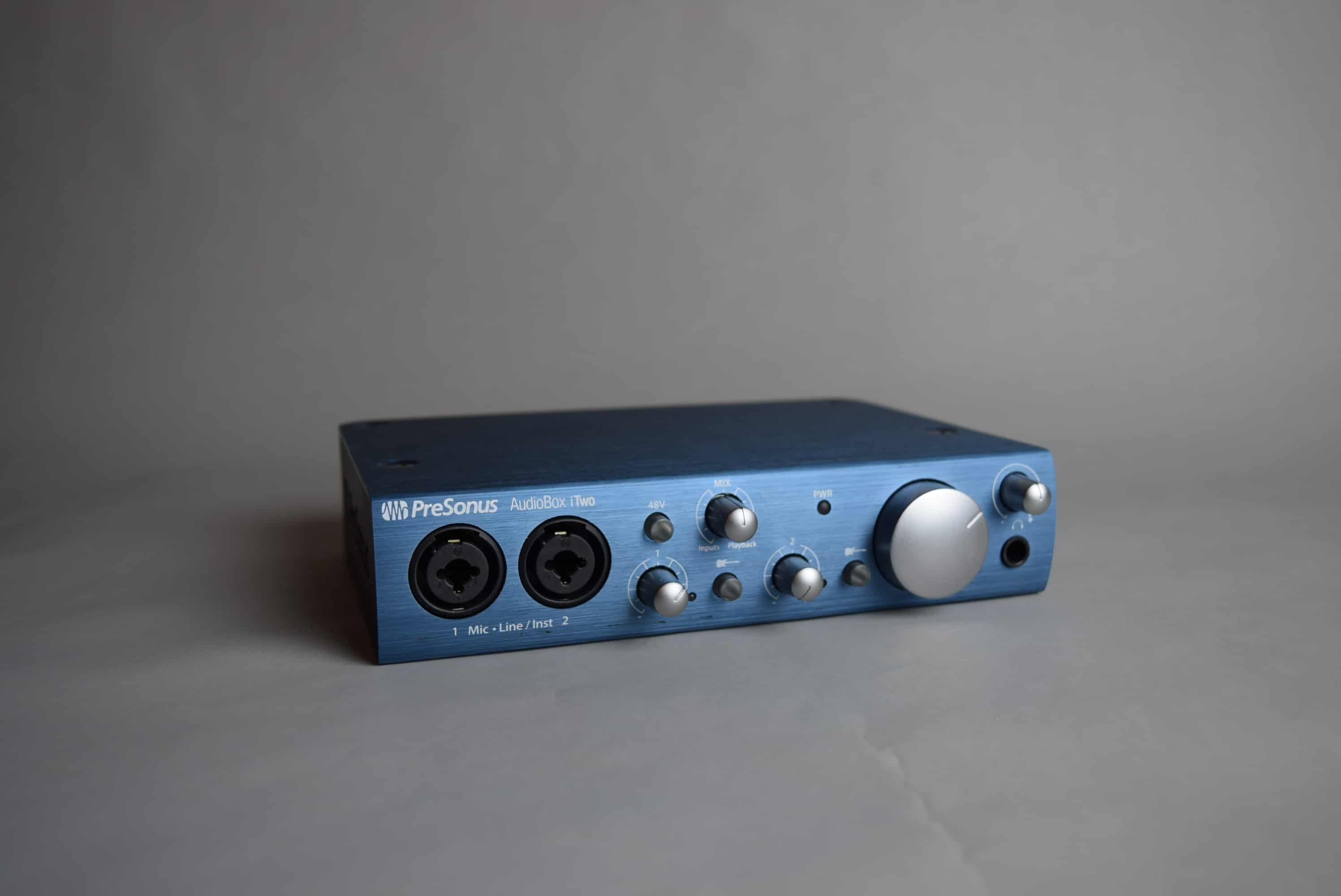
First off, I own one of these.
So let me tell you what I see as the pros with this interface.
It comes with its own Digital Audio Workstation (DAW). A DAW is a software program that you use to put together your music.
This DAW is fully functional. It has enough capability in it to produce an album. It also comes with a few software instruments and upgrades, which is a bonus.
And it can be used as an interface with an iPad which is an added bonus.
The downside is that it doesn’t have a direct midi connection but that’s not a huge deal. Most of the midi controllers you can get will have USB interface instead of just MIDI. So that’s not a deal-breaker in my book.
The reason I think this is a great deal is you get a good starter audio interface, a DAW, and some extra instruments and plugins. All in the sub-$200 price point. That’s a pretty good deal.
Focusrite Scarlett 2i2
This is also a pretty solid interface
The pros to this one is it comes with two different DAWs that you can try. The first DAW is Ableton, and the second is Pro Tools First. It also comes with a few plugins that you can use inside the DAW as well as a few VSTs which is a great option.
The cons on this one or that there is only speaker out on the back. And it doesn’t show that it is compatible with IOS. The cons about the included the DAWs are that they are limited in the number of tracks that they can record or arrange when you’re creating a song.
Both have a limitation of 8 or 16 tracks. This might be enough for you to create a basic song. But once you get in the more complicated arrangements 16 tracks pretty limited.
So that’s something to consider when you’re looking at that particular package.
TASCAM US-2X2 USB Audio Interface
The pros on this one is that it has two mic inputs, two line/instrument inputs, as well as midi inputs on the back.
The con on this one is it doesn’t look like it has any other included software with it. This would be the least recommended interface out of this group just because it’s strictly the interface at this point.
Roland Rubix 22 USB Audio Interface
This one also comes with mini on the back as well as to two inputs on front which is better fit and it includes Ableton Live Lite DAW, which is a good starter DAW.
It also interfaces with an iPad, which is nice
But it does not have any other included software or instruments or vsts.
So you are just getting the interface. It can be an interface for your laptop, computer, or iPad.
Audient iD4
This one is a little bit of a sleeper.
It cost just a touch more than the rest but the D/A and A/D conversion on these devices would be really clean and high quality.
You also get some included plugins and software. But I don’t know exactly which ones you get.
The reason I included this one on the list it just because of the quality.
I think this one has a quality of a higher level of interface even though it does not have all the same software that some of the other options have.
So if you’re someone that wants to have quality going into this process, this might be the interface for you to look at.
And you can go out and download any of the DAWs in a trial version. That will allow you to test out which DAW works best for you.
And that’s really the key. You have to figure out which DAW you’re most comfortable working in.
If you are interested in pursuing this full-time then I would recommend looking at this article that I put together that tells you the kinds of things you need to be thinking about before you purchase an audio interface.
